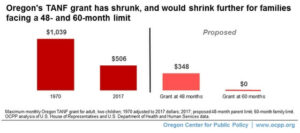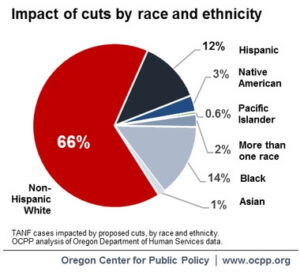This issue brief is also available as a PDF: Budget Cuts Would Make Life Harder for 11,000 of Oregon’s Poorest Children
Life would become even harder for thousands of Oregon’s poorest children if lawmakers fail to fill a budget gap. The legislature’s budget writers have proposed a list of cuts to Oregon’s Temporary Assistance for Needy Families (TANF) program that they are prepared to make in the absence of new revenue.
TANF helps families that have fallen on hard times avoid homelessness and get back on their feet. Many are single women and children escaping abuse. Because a TANF family must have few assets and little earnings to qualify, TANF serves only Oregon’s poorest households with dependent children.
The proposed cuts would drive about 11,000 Oregon children deeper into poverty, making their life prospects even bleaker.
Shorter time limits would push 7,800 children deeper into poverty
One of the threats to TANF families is a proposal to shorten the amount of time that households can receive cash assistance.[1] Budget writers have proposed cutting parents from assistance after 48 months of lifetime participation regardless of their efforts to find work, and ending all assistance to families after 60 months. These cuts would make life even harder for 3,500 struggling Oregon households, including 7,800 children.[2]
Under current Oregon law, a parent is eligible for a TANF cash grant for up to 60 months during their lifetime.[3] The household may continue to receive a reduced amount for the children, as long as the parent complies with a case plan to become employed. The 60-month limit is already arbitrary and insufficient for some households, often those with mental and physical health issues.[4] The proposal to shorten the limit even further targets the most vulnerable families: those who require more time and support to become employed.

Because families are a single economic unit, dropping a parent from assistance means the entire family — children included — sinks deeper into poverty. The current maximum grant for a parent and two children is $506 per month, a mere 30 percent of the federal poverty line.[5] Cutting off the parent after 48 months would shrink the grant to $348 per month, pushing the family to 20 percent of the poverty level. This would heighten the risk of families becoming homeless and children ending up in the foster care system. When a family is cut off entirely at 60 months, those risks would be exponentially greater.
Oregon’s TANF grant is now extremely meager, even without the proposed cuts. In 1970, the grant for a family of three was $1,039 per month in inflation-adjusted dollars — 71 percent of the federal poverty level.[6] The legislature has failed to adjust the grant to keep up with inflation.
Other cuts would harm 3,100 additional children
Besides shortening the lifetime time limit, budget writers have warned of additional cuts to TANF that would harm an additional 3,100 children.
One of the proposed cuts targets the TANF families who have disabled family members. Currently, Supplemental Security Income (SSI) payments for people with disabilities do not count toward the income limits for families in qualifying for TANF.[7] The proposal would count 50 percent of SSI received by a disabled family member in determining TANF eligibility. This would eliminate cash assistance for many households with a disabled adult, and would reduce the grant to households with a child receiving SSI.[8] The policy would impact nearly 1,300 Oregon children living in households with disability-related challenges.
Also in the crosshairs are families in which a non-parent relative — a grandparent, for example — cares for the children. Currently, a non-parent relative may receive a TANF grant on behalf of a dependent child.[9] The proposal to count the income of a “non-needy” caretaker relative when determining the grant amount would disqualify approximately 1,800 children. The cut would harm TANF children who typically have experienced family trauma.[10]
While most of those hurt by the cuts would be non-Hispanic whites, Oregonians of color would be disproportionately affected
In Oregon, non-Hispanic whites make up the largest group of TANF recipients, even though the program disproportionally helps people of color. This is not surprising, given that white Oregonians make up most of Oregon’s poor but Oregonians of color are more likely to experience poverty than non-Hispanic whites.[11]

[12] People of color comprise 23 percent of Oregon’s population and are 34 percent of those impacted by the proposed cuts. Protect Oregon’s most vulnerable children
The Governor and legislature should reject any approach that would balance the budget on the backs of Oregon’s most vulnerable children. TANF families are, by the rules governing the program, extremely poor. Children in TANF families already face severe obstacles to achieving their potential. The proposed cuts would make those challenges even greater for 11,000 children in our state. Surely, Oregon can do better.
[1] Ways and Means Co-Chairs’ 2017-19 Target Reduction Lists, Legislative Fiscal Office, Joint Committee on Ways and Means, April 17, 2017.
[2] Unless otherwise noted, all data in this fact sheet are from OCPP analysis of data provided directly or indirectly to OCPP by Jill Gray, Oregon Department of Human Services, between April 19, 2017 and April 26, 2017.
[3] Current administrative rules provide some exceptions to the 60-month time limit, including participating in the short-term subsidized JOBS Plus program, experiencing domestic violence, and caring for a child with a disability. Under these and a few other circumstances, most of which are temporary, a family may receive cash assistance after 60 months if the adult continues to carry out their case plan. Temporary Assistance to Needy Families Reinvestment: Final Recommendations: Benefits Cliff, Re-engagement, Time Limits, Community Collective Impact, Department of Human Services, February 2, 2016, pp. 10 – 13.
[4] Patton, Deleena, Melissa Ford Shah, Barbara E.M. Felver, TANF Caseload Decline: The Well-Being of Parents and Children Leaving WorkFirst in Washington State, Washington State Department of Social and Health Services, April 2015. Ovwigho, Pamela C., Kathryn Patterson and Catherine Born, The TANF Time Limit: Barriers and Outcomes among Families Reaching the Limit, Family Welfare Research and Training Group, November 2007. Also, Seefeldt, Kristin S. Watching the Clock Tick: Factors Associated with TANF Accumulation, National Poverty Center, Working Paper Series #04-9, Revised May 2005.
[5] Income and Payment Standards; REF, TANF, Oregon Administrative Rules (OAR) 461-155-0030. OCPP analysis of OAR data, using the Federal Poverty Guidelines.
[6] Oregon’s TANF grant in 1970 of $184 per month for a family of three is $1,039 adjusted to 2017 dollars. OCPP analysis of U.S. House of Representatives and Department of Health and Human Services data.
[7] OAR 461-145-0510.
[8] For a household where there is no adult TANF recipient, which would describe a household where a parent receives SSI, the income threshold is low enough that 50 percent of the typical SSI adult payment would put the household over the income eligibility threshold for TANF. Fifty percent of a child’s SSI would typically mean a household with no other income would not exceed the TANF income threshold, however the household would receive a reduced amount. Information provided to OCPP by Jill Gray, Oregon Department of Human Services, April 26, 2017.
[9] To receive TANF for a related child, a non-parent caretaker’s income cannot exceed a special threshold, which is higher than the income threshold for parents. A non-parent caretaker relative who would qualify for TANF under the usual parental income guidelines is considered a “needy” caretaker relative and could be included in the group when determining the grant amount. Otherwise, the relative is considered a “non-needy” caretaker. The proposed policy change would count “non-needy” caretaker’s income in determining the grant amount, which would effectively disqualify the family for any grant amount.
[10] Mauldon, J., Speiglman, J., Sogar, C., Stagner,M., TANF Child-Only Cases: Who Are They? What Policies Affect Them? What Is Being Done? University of Chicago, Chapin Hall, 2012, p. 8.
[11] Oregon’s Poor Still Feel Weight of the Great Recession, OCPP, October 12, 2016.
[12] The analysis of the proposed cuts by race and ethnicity does not include cuts to non-needy caretaker relative households; the data was not available by publication date. As a group, Oregonians of color would be disproportionately affected by the cuts, meaning a greater share of the TANF cuts would fall on them than their share of the overall Oregon population. Considering communities of color individually, most would be disproportionately affected by the proposed cuts, except for Hispanics and Asians.








